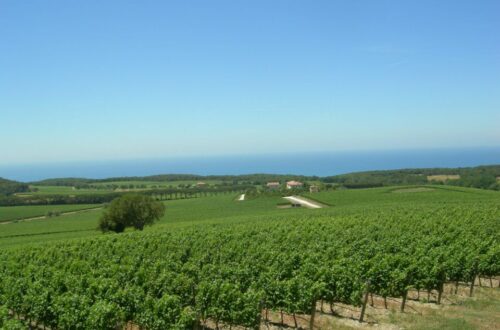Table of Contents
What Is Candia dei Colli Apuani DOC Wine?
Candia dei Colli Apuani DOC is one of Tuscany’s most distinctive micro-DOCs, a niche wine zone tucked into the marble-rich hills of Massa-Carrara. Known for its crisp Vermentino whites, rustic Barsaglina reds (locally called Massaretta), and honeyed Vin Santo, this appellation reflects a meeting point between the Alps and the Ligurian Sea.
The wines are bold yet nuanced, shaped by sea breezes, mountain slopes, and centuries of resilient viticulture in one of Italy’s most dramatic landscapes.
History of Winemaking in Massa-Carrara
Viticulture in the Apuan hills dates back to Roman times, when vineyards clung to the steep terraces above Carrara—famous for its marble quarries. In the Middle Ages, monasteries cultivated vines for both table and liturgical use. By the Renaissance, Candia’s wines appeared on noble tables in Tuscany and Liguria.
Today, the DOC (established in 1973) safeguards these traditions, celebrating indigenous grapes like Barsaglina while embracing the coastal Tuscan classic, Vermentino.
Geography & Coastal-Alpine Terroir
The Colli Apuani, or “Apuan Hills,” form a natural amphitheater where vineyards face the Ligurian Sea yet rise into Alpine foothills. This unique setting creates:
- Climate: Warm Mediterranean sun moderated by sea breezes and mountain air.
- Soils: Limestone-rich, with clay and sandy marl, echoing the marble beneath.
- Exposures: Steep terraced vineyards up to 600 meters, maximizing sunlight and drainage.
This blend of maritime freshness and mountain rigor gives Candia wines their signature minerality, tension, and aromatic lift.
Candia DOC Grapes & Wine Styles
Candia dei Colli Apuani DOC supports a wide stylistic range:
- Vermentino (white): Citrus, saline, and floral—classic coastal Tuscan energy.
- Barsaglina / Massaretta (red): Deeply hued, rustic yet elegant; black cherry, herbs, and earthy spice.
- Vermentino Nero: A rarity, offering red fruit brightness with a silky finish.
- Rosato: Fresh and summery, often from Sangiovese or Barsaglina.
- Vin Santo: Golden dessert wine made from Trebbiano and Malvasia grapes, dried before fermentation.
Winemaking Rules & DOC Requirements
The DOC outlines specific regulations to preserve authenticity:
- White wines: Must contain at least 70% Vermentino.
- Reds & rosatos: Primarily Barsaglina, Vermentino Nero, and Sangiovese blends.
- Vin Santo: Crafted via appassimento (grape-drying) with strict aging in small barrels.
- Aging: Reds require a minimum of 2 years for Riserva designation.
These rules ensure wines balance tradition with quality control, while allowing artisanal expression.
Key Facts at a Glance
- Region: Tuscany (Massa-Carrara province)
- Established: 1973
- Main Grapes: Vermentino, Barsaglina, Vermentino Nero, Trebbiano, Malvasia
- Wine Styles: White, Red, Rosato, Vin Santo
- Terroir: Coastal-Alpine with limestone soils
- Specialty: Vermentino whites & Barsaglina reds
Tasting Notes by Style
| Style | Aromas & Flavors | Texture | Best For |
| Vermentino White | Lemon zest, wild herbs, sea salt | Crisp, mineral-driven | Aperitivo, seafood |
| Barsaglina Red | Black cherry, violet, Mediterranean scrub | Firm tannins, rustic elegance | Meat stews, Tuscan charcuterie |
| Vermentino Nero | Redcurrant, pomegranate, spice | Silky, medium-bodied | Roast chicken, pasta al pomodoro |
| Vin Santo | Honey, dried apricot, almond | Lush, lingering sweetness | Cantucci, aged cheeses |
Serving Temperatures & Pairing Ideas
- Vermentino White: Serve chilled at 10–12°C with grilled fish or pasta alle vongole.
- Barsaglina Red: Best at 16–18°C alongside lamb, wild boar ragù, or Tuscan pecorino.
- Vin Santo: Serve slightly chilled at 12–14°C with biscotti or Gorgonzola dolce.
Where to Buy Candia dei Colli Apuani DOC Wines
These wines are niche and artisanal, but increasingly available through specialty Italian wine importers in the U.S., UK, and Japan. Expect:
- Vermentino whites: $15–25
- Barsaglina reds: $20–35
- Vin Santo: $30–60 (half bottle)
Tip: Look for boutique producers from Massa-Carrara or wine clubs specializing in Tuscan micro-DOCs.
FAQs About Candia dei Colli Apuani DOC
Is Candia dei Colli Apuani DOC part of Chianti?
No—while both are Tuscan, Candia is in coastal Massa-Carrara, distinct from Chianti’s inland hills.
What makes Barsaglina unique?
This indigenous grape offers both rustic intensity and aromatic finesse, making it one of Tuscany’s most intriguing reds.
Is Vin Santo always sweet?
Yes, but styles range from lusciously honeyed to more nutty and oxidative.
Are these wines collectible?
While not globally famous, Barsaglina and Vermentino Nero bottlings from top producers are increasingly sought by adventurous collectors.
Cultural Highlights & Fun Facts
- Marble & Wine: Vineyards share the same hillsides as Carrara’s marble quarries, supplying Michelangelo’s David.
- Ligurian Link: The wines stylistically bridge Tuscany and Liguria, with Vermentino appearing in both regions.
- Rare Grapes: Barsaglina was nearly extinct in the 20th century—saved by local growers.
Call to Action
🍷 Curious about Tuscany beyond Chianti? Join the Drink Italian community for insider guides to Italy’s most fascinating wine zones. Share your Candia dei Colli Apuani tasting stories with us on Instagram using #DrinkItalian.


